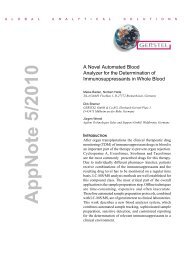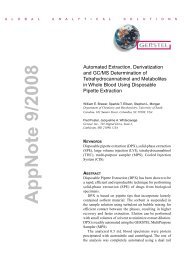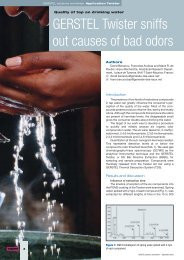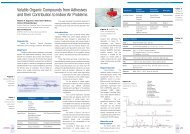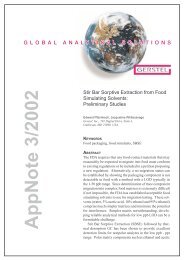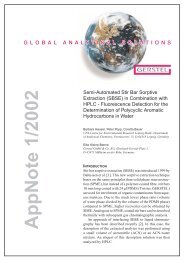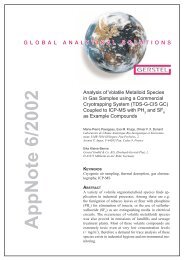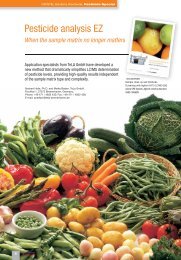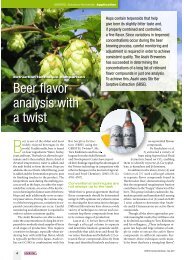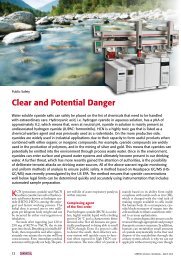GERSTEL Solutions No. 7 (pdf; 1,86 MB)
GERSTEL Solutions No. 7 (pdf; 1,86 MB)
GERSTEL Solutions No. 7 (pdf; 1,86 MB)
Create successful ePaper yourself
Turn your PDF publications into a flip-book with our unique Google optimized e-Paper software.
<strong>GERSTEL</strong> <strong>Solutions</strong> Worldwide Application<br />
Foto: wikipedia<br />
Extraction technique comparison<br />
Beer flavor<br />
analysis with<br />
a twist<br />
Hops contain terpenoids that help<br />
give beer its slightly bitter taste and,<br />
if properly combined and controlled,<br />
a fine flavor. Since variations in terpenoid<br />
concentrations occur during the beer<br />
brewing process, careful monitoring and<br />
adjustment is required in order to achieve<br />
consistent quality. The Asahi Breweries<br />
has succeeded in determining the<br />
concentrations of a long list of relevant<br />
flavor compounds in just one analysis.<br />
To achieve this, Asahi uses Stir Bar<br />
Sorptive Extraction (SBSE).<br />
Beer is one of the oldest and most<br />
widely enjoyed beverages in the<br />
world. Traditionally, beer is based<br />
on four ingredients: Water, barley,<br />
yeast and hops. The barley is allowed to germinate<br />
and is then malted, that is, dried at<br />
elevated temperatures; water is added, and<br />
the malt boiled to form the wort. Hops are<br />
added as the wort boils. After filtering, yeast<br />
is added and the fermentation process puts<br />
its finishing touches to the product. The<br />
temperature used during the malting process<br />
as well as the hops, or rather the terpenoids<br />
they contain, are some of the key factors<br />
in forming the distinct taste of the brew.<br />
Hops and malt additionally serve as natural<br />
preservatives. During the various stages<br />
of the brewing process, variations in terpenoid<br />
concentrations can occur. Careful<br />
monitoring and adjustment is required in<br />
order to achieve consistent quality.<br />
The Asahi Breweries are able to determine<br />
the concentrations of a long list of terpenoids<br />
in modestly sized samples of beers<br />
at all stages of production. This requires<br />
a sensitive technique, especially when analyzing<br />
beer with mild hop flavor, which<br />
is typically preferred in Japan. Asahi relies<br />
on GC/MS in combination with Stir<br />
Bar Sorptive Extraction<br />
(SBSE) using the<br />
<strong>GERSTEL</strong> Twister®. Mr.<br />
Toru Kishimoto and his colleagues<br />
from the Asahi Research<br />
and Development Centre have reported<br />
their findings regarding the advantages of<br />
the Twister technology in comparison with<br />
other techniques, in the Journal of Agricultural<br />
and Food Chemistry [2005; 53(12);<br />
4701-4707].<br />
Conventional techniques are<br />
not always up to the task<br />
While there is general agreement that hop<br />
flavor compounds should be determined<br />
using GC/MS, opinions vary when it comes<br />
to choosing the best extraction technique.<br />
Different laboratories have chosen a wide<br />
variety of techniques to extract and concentrate<br />
hop flavor compounds from beer<br />
in its various stages of production:<br />
Lam et al. [1] let two liters of beer run<br />
through a silica gel column to separate<br />
and determine linaloole, geraniole and -<br />
citronellole that add citrus and floral flavor<br />
notes. Steinhaus and Schieberle [2] extracted<br />
flavor compounds directly from<br />
hops and identified linaloole and myrce-<br />
ne as potential flavour<br />
compounds.<br />
De Keukeleire et al.<br />
[3] extracted a variety of<br />
hops using Supercritical Fluid<br />
Extraction, based on CO 2<br />
, enabling<br />
them to identify myrcene, -Caryophyllene,<br />
-humulene and -farnesene.<br />
In addition to the above, Irwin [4] and<br />
Goiris et al. [5] used a silica gel column<br />
to separate flavor compounds found in<br />
Hersbrucker Beer; demonstrating clearly<br />
that the oxygenated sesquiterpene fraction<br />
contributes to the “hoppy” character of the<br />
beer. This group includes eudesmole, humulene<br />
epoxide and humulenole II among<br />
others. Lermusieau et al. [6] used an XAD<br />
2 resin column to determine that linaloole<br />
and -Damascenone are active flavor<br />
compounds.<br />
Though all the above approaches provide<br />
meaningful results, they still leave a lot<br />
to be desired according to Toru Kishimoto<br />
and his colleagues.: „These techniques require<br />
raw hops and large volumes of sample<br />
in order to extract the active flavor<br />
compounds in sufficient amounts. Furthermore,<br />
these techniques work mainly<br />
for beers that have a strong hop flavor”.<br />
4<br />
<strong>GERSTEL</strong> <strong>Solutions</strong> Worldwide – May 2007



